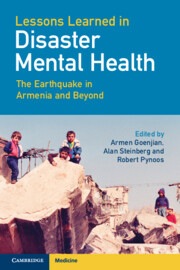Book contents
- Lessons Learned in Disaster Mental Health: The Earthquake in Armenia and Beyond
- Frontispiece
- Lessons Learned in Disaster Mental Health: The Earthquake in Armenia and Beyond
- Copyright page
- Contents
- Dedication
- Preface
- Contributors
- Chapter 1 The 1988 Spitak Earthquake in Armenia and the Implementation of the Psychiatric Outreach Program
- Chapter 2 Diaspora Therapists Working in the Earthquake Zone
- Chapter 3 Treatment Outcome among Early Adolescents Two Decades Post-Earthquake
- Chapter 4 Course and Predictors of PTSD and Depression among Not Treated Children and Adolescents over Two Decades
- Chapter 5 Conscience, Moral Injury, and Psychopathology
- Chapter 6 Natural Disasters and Relocation
- Chapter 7 Long-Term Course of PTSD and Depression Among Adults, Mediating and Moderating Factors in Recovery, and Current Trends for Treatment
- Chapter 8 How the Spitak Earthquake Contributed to our Understanding of the Genetics of PTSD and Associated Disorders
- Chapter 9 Epidemiology of Disasters and the Spitak Earthquake
- Chapter 10 Traumatic Stress Conceptual Framework
- Chapter 11 Memoirs of the Spitak Earthquake
- Chapter 12 Lessons Learned from the Spitak Earthquake and Other Catastrophic Disasters
- Index
- Plate Section (PDF Only)
- References
Chapter 3 - Treatment Outcome among Early Adolescents Two Decades Post-Earthquake
Published online by Cambridge University Press: 20 May 2022
- Lessons Learned in Disaster Mental Health: The Earthquake in Armenia and Beyond
- Frontispiece
- Lessons Learned in Disaster Mental Health: The Earthquake in Armenia and Beyond
- Copyright page
- Contents
- Dedication
- Preface
- Contributors
- Chapter 1 The 1988 Spitak Earthquake in Armenia and the Implementation of the Psychiatric Outreach Program
- Chapter 2 Diaspora Therapists Working in the Earthquake Zone
- Chapter 3 Treatment Outcome among Early Adolescents Two Decades Post-Earthquake
- Chapter 4 Course and Predictors of PTSD and Depression among Not Treated Children and Adolescents over Two Decades
- Chapter 5 Conscience, Moral Injury, and Psychopathology
- Chapter 6 Natural Disasters and Relocation
- Chapter 7 Long-Term Course of PTSD and Depression Among Adults, Mediating and Moderating Factors in Recovery, and Current Trends for Treatment
- Chapter 8 How the Spitak Earthquake Contributed to our Understanding of the Genetics of PTSD and Associated Disorders
- Chapter 9 Epidemiology of Disasters and the Spitak Earthquake
- Chapter 10 Traumatic Stress Conceptual Framework
- Chapter 11 Memoirs of the Spitak Earthquake
- Chapter 12 Lessons Learned from the Spitak Earthquake and Other Catastrophic Disasters
- Index
- Plate Section (PDF Only)
- References
Summary
There is a paucity of long-term treatment outcome studies among children and adolescents after natural disasters. This chapter summarizes findings from three long-term studies among severely traumatized early adolescents after the 1988 Spitak earthquake in Armenia, including a twenty-five-year follow-up that represents the most extended prospective treatment outcome study to date after a disaster. School-based trauma-grief-focused psychotherapy was provided at 1.5 years post-earthquake. The intervention addressed trauma and loss experiences due to the earthquake; post-trauma distress reactions, including PTSD and grief; current problems and adversities; trauma and loss reminders, interpersonal conflicts, and developmental progression. The findings showed significant long-term benefits of treatment in reducing PTSD and depressive symptoms. We also present findings regarding differences in recovery trajectories among treated and not treated subjects and risk and protective factors associated with PTSD and depression. Despite the improvements, a sub-group of the students continued to experience earthquake-related chronic PTSD and depressive symptoms at twenty-five-year follow-up, indicating the need for ongoing surveillance of severely traumatized survivors. The findings underscore the benefit of post-disaster therapeutic intervention, social support by family members and friends, and the need for assistance by governmental and non-governmental agencies to mitigate post-disaster adversities that contributed significantly to the chronicity of symptoms.
Keywords
- Type
- Chapter
- Information
- Lessons Learned in Disaster Mental HealthThe Earthquake in Armenia and Beyond, pp. 18 - 47Publisher: Cambridge University PressPrint publication year: 2022



